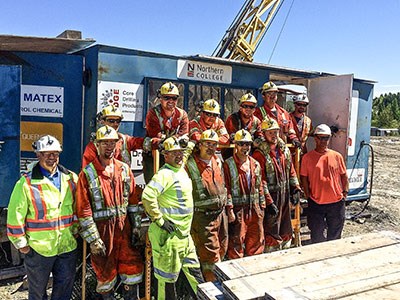Rose-Lyne D’Aoust-Messier is seeing the subtle signs that the mineral exploration sector is on the rebound.
The training consultant at Northern College is seeing renewed interest from drilling contractors who are looking to scoop up past and current graduates from the college’s diamond driller assistant common core program.
“It’s really exciting to see that happen again. I never thought I would see it again in my work life,” said D’Aoust-Messier.
Due to industry demand, the college announced in late August that seats were open to its 10-week driller’s helper program, the second offering this calendar year.
“We’re starting back up, running two programs a year,” said D’Aoust-Messier.
“If the demand is there, we will be putting on a winter program. We haven’t had three in a while.”
When the exploration industry has been at its peak, Northern ran the program three times annually — the last time being in 2010 — before it slipped to once a year as global mineral prices began to tank.
But instead of placing the program on hiatus, the college was urged by their industry partners to keep it going.
“They were asking us to continue even if we had a small group of six and eight students. We can accommodate up to 12,” said D’Aoust-Messier.
“If the direction was to put it in abeyance, we would’ve done so. We didn’t, we maintained it.”
After past industry slumps, contractors were able to recall their drillers and helpers.
“This time, no one’s standing. Many are in their 60s and not interested in doing hard, physical labour.”
But the demand for labour remains as contractors contact her, looking to track down graduates or inquire if they can provide student placements.
“That’s a very clear indication that there’s a need out there,” said D’Aoust-Messier.
“I’ve been speaking with manufacturers calling us to ask if they can provide us with up-to-date, state-of-the-art equipment and trainers to come onto the site. When you hear that you know there’s something brewing.”
Most of the training takes place at the former Toburn Mine in Kirkland Lake, just a stone’s throw from the campus.
After offering only surface training, the program curriculum has been rejigged to provide an underground experience.
Alamos Gold has stepped up to allow Northern’s trainers and students to go below ground at the Young-Davidson Mine in Matachewan to teach some of the modules in a special training area.
“It’s actually a real good opportunity to gauge if they’re comfortable with that environment,” said D’Aoust-Messier.
“The worst thing that can happen is an employer hires one of our students — gets them trained and geared up — and they send them underground and they don’t make it through a day because they’re hyperventilating in the cage and having anxiety attacks.
“That actually eliminates that situation and the students themselves can make a better career choice. They may choose to be a surface diamond driller helper instead of going underground, while others will love it.”
The various modules teach trainees how to work safely in a drilling environment; how to operate hands and power tools, run generators, chainsaws, and tracked vehicles; and give them a greater awareness on how to work around heavy and moving equipment.
D’Aoust-Messier said that basically certifies them to work in a multitude of hard-hat environments.
Graduates have worked in construction in Western Canada and on hydro-electric dam projects in Labrador because of their health and safety certification.
Those who demonstrate their competency in these skills usually have a job waiting for them.
“Very much so,” said D’Aoust-Messier.
“This past spring, we were calling the students up to accept their certificates and our industry partners are standing on the stage shaking their hands and saying, call me Monday.
“They’re being offered jobs right off the bat. Within six weeks, all of our students were hired. We had some starting the week after graduating.”
About a half-dozen drilling companies work with the college to provide one-week placements, thus allowing the contractor to evaluate a potential hire.
A student is assigned to an operating drill rig as a “third man” to job-shadow the helper.
The key to the program’s longevity has been industry partnerships with companies like Kirkland Lake Gold, Forage Orbit Garant, Boart Longyear and Atlas Copco, the latter who services the college’s Christensen CS10 surface drill in exchange for having access to the Toburn site to conduct product testing.
Since 2007, the program has produced 246 graduates with students coming from the Yukon, New Brunswick and Zimbabwe.
The college is also making inroads into Canada’s Far North.
It’s cultivated a relationship with the Nunavut hamlet of Arviat and the nearby Agnico Eagle mine to deliver the diamond drilling program there. To date, the school has trained close to 60 Inuit students.




